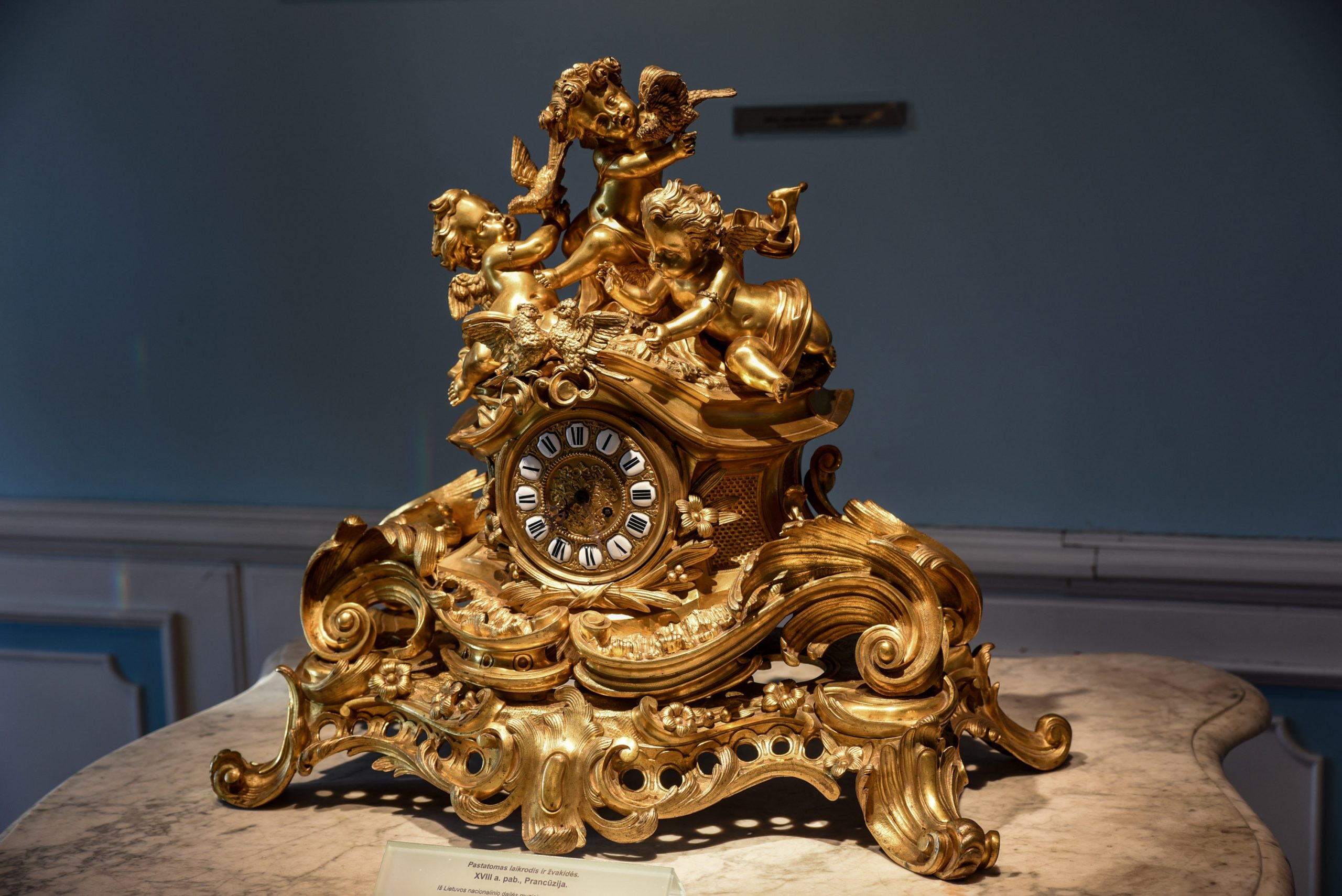Permanent exhibition "History of the Clock Structures from the Ancient Times till the Present and Development of the Clock Form since Renaissance till Art Moderne"

Development of clocks forms
The clocks and watches are exhibited in the five halls on the first floor. They show the change of form cases from Renaissance to Modern Styles. The decoration of all styles reflects the development of applied – decorative art, in general, outline. The style of the epoch is reflected not only by the design of clocks and watches but also by specially selected works of applied – decorative and imitative art in each hall. Every hall, on the first floor, has a colorful background, which characterizes the style of the certain epoch. It is created by the color of the walls, curtains and materials of the stands. The style of the epoch in each hall is featured by the furniture of that period.
Original clocks and watches of 16th – 17th centuries are exhibited in the first hall. The case of the silver clock, made in the 16th century, is the pride of the museum. It is considered, that this clock was made of Vilnius watchmaker guild and was presented as a gift to the manor of Zygimantas Augustas. The shape and decoration of this clock case reflect the characteristic features of Renaissance. The clocks and watches were made of a shape, resembling the buildings or towers. Hexagonal shape table clocks are exhibited separately. Theodor Tarasowig, a clockmaker of Vilnius, made one of them in 17th century.
The baroque clocks and watches are shown in the other hall. The main part of this exposition consists of bracket clocks, long-case clocks, and wall and mantel clocks. You can be aquatinted with bracket clocks made by remarkable English masters Eardley Norton and William Rust. You can also see long case clock, made by Francis Wells. There is an interesting 18th-century pendule made by Swiss Theodore Perret clock made in the technique of French master Charles Boulle.
The rococo style clocks and watches are shown in the third hall. The characteristic features of this style are asymmetrical, but having a proper balanced and rhythm form, rocaille (shells and rock work) and sophisticated light line design. The 18th-century French mantel gild-bronze clock with the candlesticks is the exact example of that time. A German porcelain case clock astonishes by its lightness and elegance. Some collection of this period watches is exhibited in this hall.
Classicism revived the traditions of antique art. Moderated by decorated, symmetrical compositions were spread. Mainly two types of cases were made at that time: The compositions of different figures arranged on a rectangle base and clocks mounted in a Doric ‘porico’- style cases. The mantel and table clocks made by French and German masters are exhibited in this hall. The collection of watches contains the examples of famous French master Abraham Louis Breguet.
The Eclectic style of the mid 19th and the end 19th century is presented by table and mantel clocks made by a German firm ’Lenzkirch’ and Conrad Felsing Berlin clockmaker. Their cases reflect the forms of several intertwined historical epochs. The exposition ends with Modern clocks and watches, produced at the end of the 19th the beginning of 20th century. Wall and table clocks of serial produced by German firms ‘Gustav Becker’, ‘Junghans’ are shown in this hall. A big collection of watches represents the items made in different countries.
Constructions of timekeeping devices
The clocks and watches exhibited in the four halls on the first floor show the change of form cases.
Each part of the development history is illustrated by engravings, schemes and explanatory texts, made by Romualdas Martinkus. The history of ancient calendars, when the day and night were not divided into hours is shown in two stands of the first floor. The Primitive Moon, Moon and Sun and Sun calendars are demonstrated. The models of primitive wooden Siberian peg and leather South American knotty calendars are represented there. The description of Sun calendars is supplemented by interesting original exhibits of calendars, made by Lithuanian folk masters. Sundials are exhibited in five stands. They are shadow length and shadow direction vertical and horizontal, spherical and equatorial sundials. There were created models of Egyptian marble shadow length sundials and star clocks (nocturnal) of 3000 BC to reveal this theme. A kinetic stands in the centre of the first-floor supplement the exposition of sundials. Sundials, which are lit up by a lamp, are exhibited on the turning round plane surface. The movement of a shadow, which falls from gnomons, grounds the producing principle of these clocks.
The exposition of water clocks is shown in the rest stands of the first floor. The flowing out and flowing in, overflowing water clocks, water clocks with indirect time indication, water clocks – automatic machines exposition of water clocks are exhibited. The water clocks had never been created in Lithuania before. There are not many left in the world. The models Greek stoneware and the models of Asian countries out flowing and European overflowing water clocks were created in order to show the construction of these clocks.
The fire and sand clocks are exhibited in the second hall. Fire clocks are shown in three stands: fire clocks – wicks, candles and oil lamps. The models wooden Chinese straight wick’s and brass helical wick’s fire clocks, candles of different types (simple and with sound indication), three types oil lamps were created, because such clocks did not remain in Lithuania. The original Chinese 19th-century censer and two Chinese vases with the drawings of four seasons of the year are an interesting addition to the collection of exhibits. Corresponding vases could be used as the smell clocks.
Sand clocks, from old times until nowadays, are shown in two stands. Glass was used to make clocks. It is brittle material, thus not a many of them are left. The models of first sand clocks and sand clocks models, made from four glasses, were created. According to the subject plan of the exposition, there is foreseen to arrange a big sand clock, in the centre of a hall, designed by Romualdas Martinkus. It should be turned upside down while opening the museum. Sand should fall all the day until the museum is closed. Mechanical clocks make the greatest collection in the Museum. The development of these clocks is shown very properly. There were not mechanical time measuring devices with the verge escapements in the 12th – 14th century in Lithuania. The model of such a construction was created to show that. Separate parts of mechanical clocks: engines – weights and watch-springs, regulators – pendulums and balances are exhibited there. The original mechanical clocks of the 13th – 20th centuries and the texts and schemes in the placards show the development of separate inventions and the development scientific works in detail. In the stands of balanced clocks, there are exhibited constructions of different experimental balance models. Working tower clock of Klaipėda old fire station, which was made in Berlin in 1856 is exhibited in the centre of a hall. There are two 14th century standing balance clocks (made in Lithuania) stand near to it.
The newest mechanical, electromechanical, electromagnetic, electronic, quartz and quantum clocks united time measuring systems are presented in the fourth fall. We plan to put a clock showing all the time of all the time zones of the world in the centre of this hall. The exposition, arranged in this way, allows us to see and understand the kinds of devices used in the time measuring and how long and difficult is the way of their development. The origin comes back to the oldest times of human history.
12 Liepų st, LT-92114, Klaipėda, Lithuania.
+370 46 410 413,
+370 46 410 414;
fax +370 46 410 417;
laikrodziu.muziejus@lndm.lt













